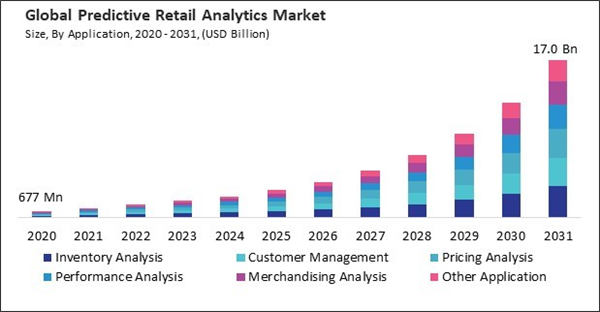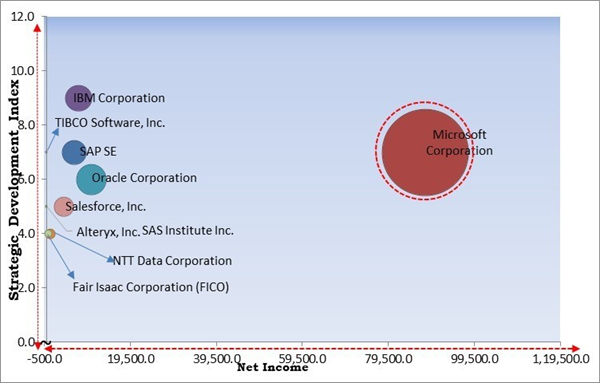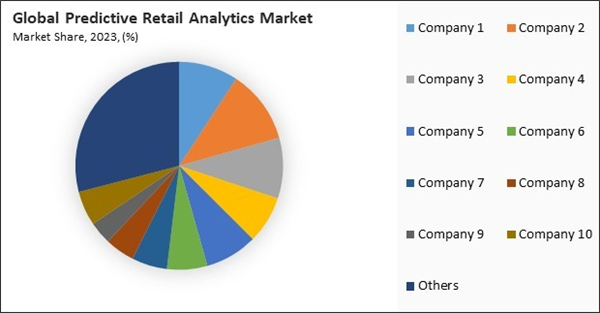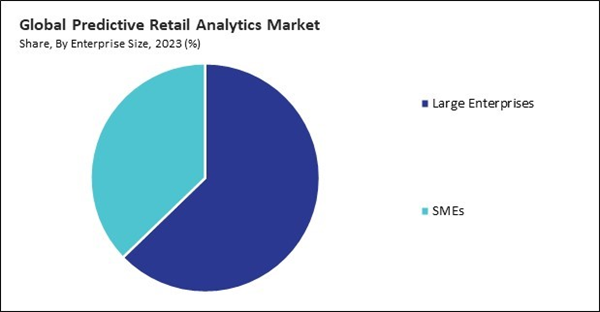The Global Predictive Retail Analytics Market size is expected to reach $17 billion by 2031, rising at a market growth of 33.2% CAGR during the forecast period.
Retailers are increasingly focused on optimizing in-store and online performance to improve customer satisfaction and reduce operational costs. Performance analysis tools allow businesses to monitor metrics such as sales trends, staff productivity, and inventory turnover, helping them adapt quickly to market changes. The rise in e-commerce and omnichannel strategies has further amplified the need for performance analysis, as retailers strive to maintain consistent service quality and seamless customer experiences across platforms. Thus, the performance analysis segment procured 15% revenue share in the predictive retail analytics market in 2023.
ac
The major strategies followed by the market participants are Partnership as the key developmental strategy to keep pace with the changing demands of end users. For instance, In August, 2024, Alteryx partnered with Udacity, an American educational company, to launch a comprehensive data preparation course using Alteryx Designer. This partnership aimed to expand AI and data literacy, offering hands-on training to equip learners with essential skills for predictive analytics, supporting the growing demand for data-savvy professionals in modern organizations. Additionally, In June, 2024, IBM Corporation partnered with Telefónica Tech, a Spanish telecommunications company, to enhance AI, analytics, and data governance solutions in Spain. This partnership would develop an open, hybrid, multi-cloud platform, SHARK.X, featuring IBM's watsonx AI and Data platform.
Additionally, the retail landscape has been further complicated by the emergence of omnichannel retailing, which involves the integration of multiple sales channels, including online platforms, physical stores, and mobile applications, to deliver a seamless customer experience. Consequently, retailers that implement predictive analytics are more effectively positioned to satisfy the growing demand and preserve their market position as e-commerce expands.
The leading players in the market are competing with diverse innovative offerings to remain competitive in the market. The above illustration shows the percentage of revenue shared by some of the leading companies in the market. The leading players of the market are adopting various strategies in order to cater demand coming from the different industries. The key developmental strategies in the market are Partnerships, Collaborations & Agreements.
The predictive retail analytics market is highly competitive, driven by demand for data-driven insights in consumer behavior, personalized experiences, and inventory optimization. Key attributes include advanced AI, machine learning, and real-time data processing, enabling retailers to forecast demand, optimize pricing, and enhance customer loyalty. High accuracy, scalability, and integration capabilities are essential for effective deployment. As customer expectations evolve, the competition intensifies, with players focusing on innovation, ease of use, and analytics depth to stand out in a rapidly advancing landscape.
Retailers are increasingly focused on optimizing in-store and online performance to improve customer satisfaction and reduce operational costs. Performance analysis tools allow businesses to monitor metrics such as sales trends, staff productivity, and inventory turnover, helping them adapt quickly to market changes. The rise in e-commerce and omnichannel strategies has further amplified the need for performance analysis, as retailers strive to maintain consistent service quality and seamless customer experiences across platforms. Thus, the performance analysis segment procured 15% revenue share in the predictive retail analytics market in 2023.
ac
The major strategies followed by the market participants are Partnership as the key developmental strategy to keep pace with the changing demands of end users. For instance, In August, 2024, Alteryx partnered with Udacity, an American educational company, to launch a comprehensive data preparation course using Alteryx Designer. This partnership aimed to expand AI and data literacy, offering hands-on training to equip learners with essential skills for predictive analytics, supporting the growing demand for data-savvy professionals in modern organizations. Additionally, In June, 2024, IBM Corporation partnered with Telefónica Tech, a Spanish telecommunications company, to enhance AI, analytics, and data governance solutions in Spain. This partnership would develop an open, hybrid, multi-cloud platform, SHARK.X, featuring IBM's watsonx AI and Data platform.
Cardinal Matrix - Market Competition Analysis
Based on the Analysis presented in the Cardinal matrix; Microsoft Corporation are the forerunners in the Predictive Retail Analytics Market. In June, 2023, Microsoft Corporation signed a partnership with Moody’s, a financial services company. The partnership aimed to develop advanced data, analytics, and risk solutions using Microsoft Azure OpenAI Service. Companies such as Oracle Corporation, IBM Corporation, SAP SE are some of the key innovators in Predictive Retail Analytics Market.Market Growth Factors
Retailers are integrating AI and ML algorithms into their operations to gain deeper insights into customer behavior. This allows them to anticipate needs and tailor strategies accordingly. For example, machine learning models can analyze customer purchase histories, browsing patterns, and preferences to create personalized shopping experiences. This enhances customer satisfaction and drives loyalty as shoppers return to brands that understand their needs.Additionally, the retail landscape has been further complicated by the emergence of omnichannel retailing, which involves the integration of multiple sales channels, including online platforms, physical stores, and mobile applications, to deliver a seamless customer experience. Consequently, retailers that implement predictive analytics are more effectively positioned to satisfy the growing demand and preserve their market position as e-commerce expands.
Market Restraining Factors
As predictive analytics becomes more integral to retail, concerns about data privacy have grown significantly. Regulations like the General Data Protection Regulation (GDPR) in Europe and the California Consumer Privacy Act (CCPA) in the United States have set stringent standards for how businesses collect, store, and use consumer data. These laws aim to protect consumer privacy, granting individuals greater control over their personal information and ensuring transparency in data usage. Hence, such factors may impede the growth of the market.The leading players in the market are competing with diverse innovative offerings to remain competitive in the market. The above illustration shows the percentage of revenue shared by some of the leading companies in the market. The leading players of the market are adopting various strategies in order to cater demand coming from the different industries. The key developmental strategies in the market are Partnerships, Collaborations & Agreements.
Driving and Restraining Factors
Drivers
- Increasing adoption of AI and machine learning
- Shift toward e-commerce and omnichannel retailing
- Rising demand for personalized shopping experiences
Restraints
- Risk of data breaches and misuse of customer data
- Requirement of substantial initial investment
Opportunities
- Surge in Big Data and IoT implementation
- Rising demand for fraud detection and risk management
Challenges
- Substantial lack of skilled personnel
- Competition from e-commerce giants
Application Outlook
Based on application, the market is segmented into inventory analysis, customer management, pricing analysis, performance analysis, merchandising analysis, and others. The inventory analysis segment witnessed 23% revenue share in the market in 2023. This segment's growth is fueled by retailers' need to optimize stock levels, reduce costs, and enhance supply chain efficiency.Business Function Outlook
By business function, the market is divided into supply chain management, sales & marketing, strategy & planning, in-store operations, human resource, and others. supply chain management segment procured 25% revenue share in the market in 2023. This segment's growth is driven by retailers' need to optimize inventory levels, enhance demand forecasting, and improve logistics efficiency.Enterprise Size Outlook
On the basis of enterprise size, the market is bifurcated into large enterprises and SMEs. The SMEs segment recorded 37% revenue share in the market in 2023. While Small & medium enterprises (SMEs) may have smaller budgets, the growing availability of scalable, cloud-based analytics solutions has made it easier for them to adopt predictive analytics.Services Outlook
The services segment is further segmented into consulting services, deployment & integration services, support & maintenance services, and training & education services. The support & maintenance services segment garnered 19% revenue share in the market in 2023. As predictive analytics solutions become more complex and integral to retail operations, ongoing support and maintenance are essential to ensure optimal performance.Component Outlook
On the basis of component, the market is bifurcated into software and services. The software segment acquired 63% revenue share in the market in 2023. This dominance results from the growing demand for sophisticated analytics tools that allow retailers to analyze large volumes of data, predict trends, and make data-driven decisions.Deployment Outlook
Based on deployment type, the market is classified into cloud-based, on-premise, and hybrid. The on-premise segment procured 29% revenue share in the market in 2023. The need for enhanced data security, control, and compliance with industry regulations primarily drives this segment.Regional Outlook
Region-wise, the market is analyzed across North America, Europe, Asia Pacific, and LAMEA. The Europe segment garnered 29% revenue share in the market in 2023. The region's mature retail sector, coupled with a high adoption rate of advanced digital technologies, has led to strong demand for predictive analytics solutions.Market Competition and Attributes
The predictive retail analytics market is highly competitive, driven by demand for data-driven insights in consumer behavior, personalized experiences, and inventory optimization. Key attributes include advanced AI, machine learning, and real-time data processing, enabling retailers to forecast demand, optimize pricing, and enhance customer loyalty. High accuracy, scalability, and integration capabilities are essential for effective deployment. As customer expectations evolve, the competition intensifies, with players focusing on innovation, ease of use, and analytics depth to stand out in a rapidly advancing landscape.
Recent Strategies Deployed in the Market
- Aug-2024: Alteryx introduced new features enhancing its AI Platform for Enterprise Analytics. Key updates include Alteryx Auto Insights' improved Playbooks for self-service data exploration and Alteryx Location Intelligence's new orchestration capabilities with Alteryx Analytics Cloud (AAC) Plans, boosting efficiency and simplifying analytics for non-technical users.
- Aug-2024: Alteryx partnered with Udacity, an American educational company, to launch a comprehensive data preparation course using Alteryx Designer. This partnership aimed to expand AI and data literacy, offering hands-on training to equip learners with essential skills for predictive analytics, supporting the growing demand for data-savvy professionals in modern organizations.
- Jun-2024: IBM Corporation partnered with Telefónica Tech, a Spanish telecommunications company, to enhance AI, analytics, and data governance solutions in Spain. This partnership would develop an open, hybrid, multi-cloud platform, SHARK.X, featuring IBM's watsonx AI and Data platform.
- Apr-2024: Fair Isaac Corporation signed a partnership with Atto, an American manufacturing company, to enhance UK lenders' credit risk assessment by integrating Open Banking data into credit scoring. This partnership combined Atto's Open Banking technology with FICO's transaction data analytics, offering predictive models that improve risk management, customer acquisition, and portfolio performance for lenders in the UK.
- Apr-2024: Fair Isaac Corporation teamed up with with Cognizant, an American IT company, to launch a cloud-based, real-time payment fraud prevention solution using FICO Falcon Fraud Manager. This AI and ML-powered offering would protect banks and payment providers in North America from fraud in instant digital payments, enhancing transaction security and reducing losses.
List of Key Companies Profiled
- IBM Corporation
- Oracle Corporation
- SAP SE
- Microsoft Corporation
- SAS Institute Inc.
- NTT Data Corporation
- TIBCO Software, Inc. (Vista Equity Partners Management, LLC)
- Salesforce, Inc.
- Alteryx, Inc.
- Fair Isaac Corporation (FICO)
Market Report Segmentation
By Application
- Inventory Analysis
- Customer Management
- Pricing Analysis
- Performance Analysis
- Merchandising Analysis
- Other Application
By Enterprise Size
- Large Enterprises
- SMEs
By Component
- Software
- Services
- Consulting Services
- Deployment & Integration Services
- Support & Maintenance Services
- Training & Education Services
By Deployment Type
- Cloud-based
- On-Premise
- Hybrid
By Business Function
- Supply Chain Management
- Sales & Marketing
- Strategy & Planning
- In-store Operations
- Human Resource
- Other Business Function
By Geography
- North America
- US
- Canada
- Mexico
- Rest of North America
- Europe
- Germany
- UK
- France
- Russia
- Spain
- Italy
- Rest of Europe
- Asia Pacific
- China
- Japan
- India
- South Korea
- Singapore
- Malaysia
- Rest of Asia Pacific
- LAMEA
- Brazil
- Argentina
- UAE
- Saudi Arabia
- South Africa
- Nigeria
- Rest of LAMEA
Table of Contents
Chapter 1. Market Scope & Methodology
Chapter 2. Market at a Glance
Chapter 3. Market Overview
Chapter 4. Competition Analysis - Global
Chapter 5. Global Predictive Retail Analytics Market by Application
Chapter 6. Global Predictive Retail Analytics Market by Enterprise Size
Chapter 7. Global Predictive Retail Analytics Market by Component
Chapter 8. Global Predictive Retail Analytics Market by Deployment Type
Chapter 9. Global Predictive Retail Analytics Market by Business Function
Chapter 10. Global Predictive Retail Analytics Market by Region
Chapter 11. Company Profiles
Companies Mentioned
- IBM Corporation
- Oracle Corporation
- SAP SE
- Microsoft Corporation
- SAS Institute Inc.
- NTT Data Corporation
- TIBCO Software, Inc. (Vista Equity Partners Management, LLC)
- Salesforce, Inc.
- Alteryx, Inc.
- Fair Isaac Corporation (FICO)
Methodology

LOADING...













